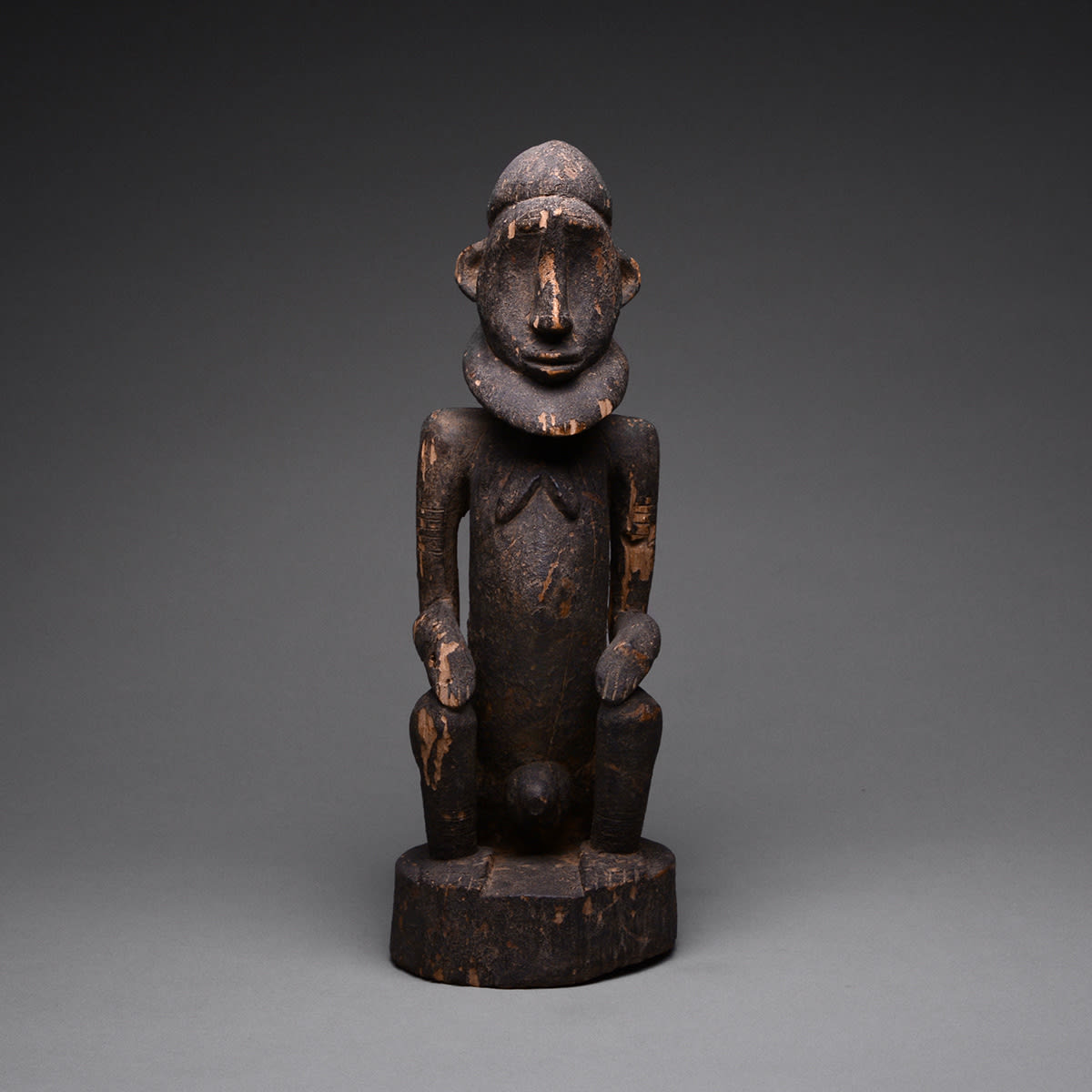Dogon Wooden Sculpture of a Seated Man, 20th Century CE
Wood
34.3 x 10.2 cm
13 1/2 x 4 in
13 1/2 x 4 in
PF.3113 (LSO)
Further images
This powerful figure of a seated man was made by the Dogon, who live on the Bandiagara Escarpment, Mali. It is a classical representation, with a circular block integral base,...
This powerful figure of a seated man was made by the Dogon, who live on the Bandiagara Escarpment, Mali. It is a classical representation, with a circular block integral base, supporting a male with an elongated trunk, an upright trunk, comparatively short limbs and an outsize, bearded head. The limbs are strongly flexed, the joints carved with incised lines and well modelled around elbows and knees. The abdomen and chest are protuberant, with slim, sharp shoulders and a columnar neck. The head is remarkable, with a wide lower jaw and a narrowing apex with a plain skullcap. The cheeks are sculpted, leaving a long, sharp nose, high, coffee-bean eyes and sharp brows. The mouth is ling and sensitively rendered, with sharply-defined lips, below which there is a plate-like beard that encircles the head from ear to ear. Detail is restricted beneath the neck; the genitalia are formed as a dome-like eminence, and there is a diadem (perhaps schematic breasts, which would make the figure a hermaphrodite) just below the neck. The surface of the piece is darkly patinated, which presumably reflects a long history of offrenda and libations being poured over it.
The Dogon have been described as the most studied and least understood tribal group in Africa. They live on the Bandiagara escarpment, Mali, a 150-mile-long eminence that supports a population of between 250,000 and 450,000. They moved to this area in the 15th century, escaping the Mande kingdom and slavery at the hands of Islamic groups, and displaced a number of tribes (including the Tellem and Niongom) that were living on the escarpment at the time. They are excessively prolific in terms of artistic production, not least because they have mastered all the main materials that are used in traditional African art; figures in stone, iron, bronze/copper and of course wood are all known, in addition to cave/rock painting and adaptation of more modern materials. There are around seventy-eight different mask forms still in production (in addition to numerous extinct variants), figural sculptures of males, females, nommos and unidentifiable individuals that have maternity and ancestor functions and a wide range of secular items decorated with iconographic designs that bestow benedictions upon the user or owner. The most important works are kept and manipulated by the spiritual leader (Hogon) away from the public eye, within the houses of families, or in sanctuaries. The scale of the population and the size of the area in which they live have resulted in considerable social and artistic diversity, and a complex interplay between tradition and innovation.
This is a powerful and impressive piece of Dogon sculpture. It displays well, and is a striking and attractive piece of African design.
The Dogon have been described as the most studied and least understood tribal group in Africa. They live on the Bandiagara escarpment, Mali, a 150-mile-long eminence that supports a population of between 250,000 and 450,000. They moved to this area in the 15th century, escaping the Mande kingdom and slavery at the hands of Islamic groups, and displaced a number of tribes (including the Tellem and Niongom) that were living on the escarpment at the time. They are excessively prolific in terms of artistic production, not least because they have mastered all the main materials that are used in traditional African art; figures in stone, iron, bronze/copper and of course wood are all known, in addition to cave/rock painting and adaptation of more modern materials. There are around seventy-eight different mask forms still in production (in addition to numerous extinct variants), figural sculptures of males, females, nommos and unidentifiable individuals that have maternity and ancestor functions and a wide range of secular items decorated with iconographic designs that bestow benedictions upon the user or owner. The most important works are kept and manipulated by the spiritual leader (Hogon) away from the public eye, within the houses of families, or in sanctuaries. The scale of the population and the size of the area in which they live have resulted in considerable social and artistic diversity, and a complex interplay between tradition and innovation.
This is a powerful and impressive piece of Dogon sculpture. It displays well, and is a striking and attractive piece of African design.







